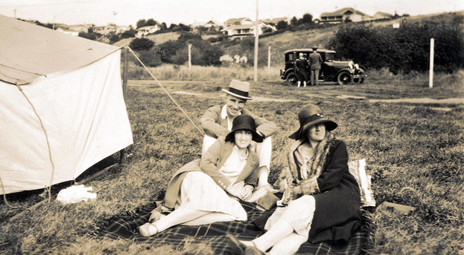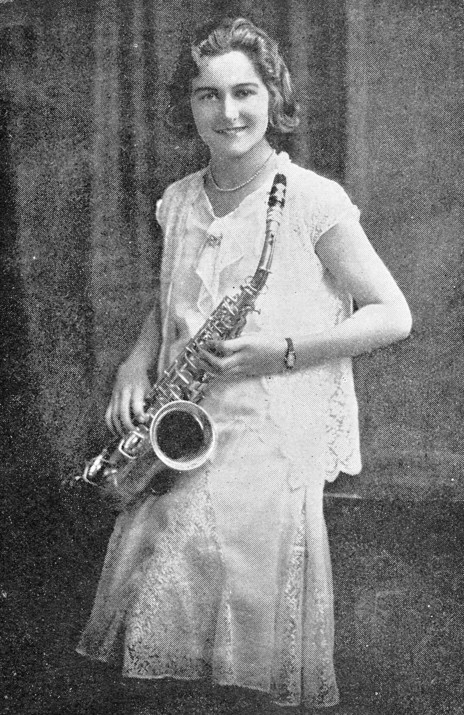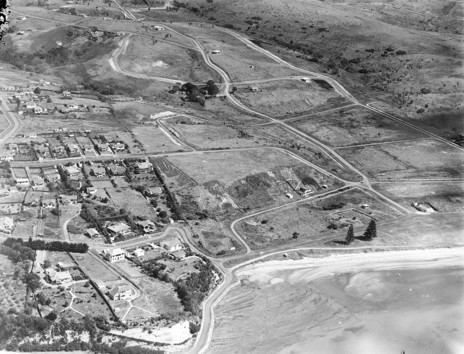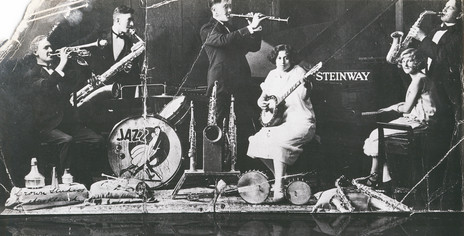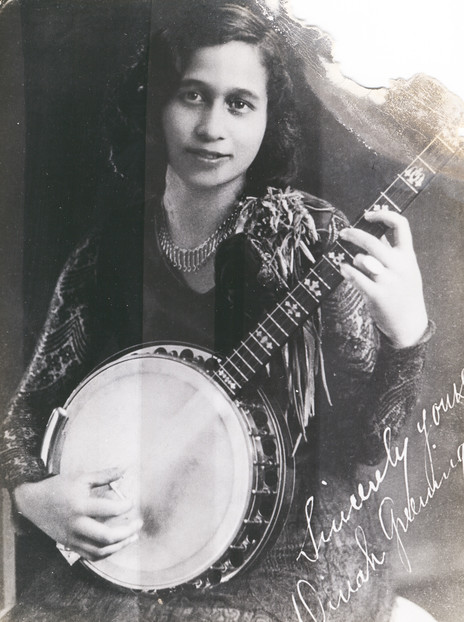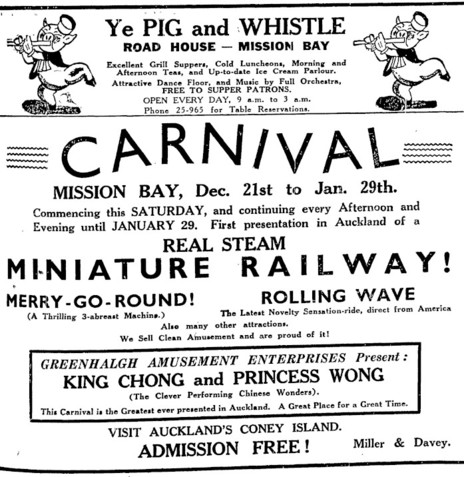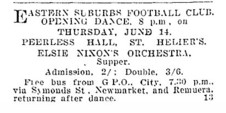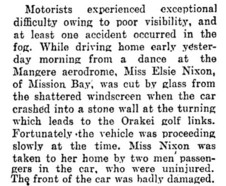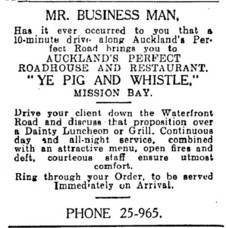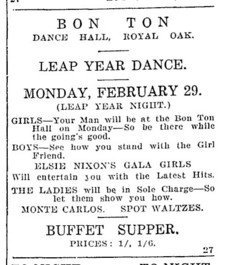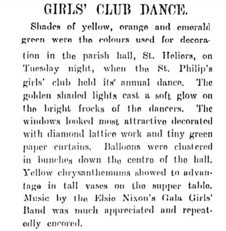As Arthur recovered, he was given music lessons to improve his breathing and muscle tone, learning banjo, guitar, steel guitar, and saxophone from music impresario, bandleader, teacher, and songwriter Walter Smith. Arthur saw how much Elsie missed her piano lessons, encouraged her to take up the saxophone, and began teaching her the basics on his own instrument.
Through Arthur’s lessons with Walter Smith, Elsie came to know his nieces Dinah and Marjorie Greening, both talented multi-instrumentalists and singers. By the late 1920s they were prominent musicians around Auckland working on vaudeville and featuring in some of their uncle’s bands, including the Aloha Jazz Band.
In 1927 Elsie and Arthur’s father, Richard, decided to develop their section in Patteson Ave, Mission Bay, Auckland. He created the Mission Bay Tea Rooms and Cabaret, also known as Nixon’s Cabaret: an open-air tearoom and cabaret for beach trippers, hosting dances most evenings. (A 1928 advertisement said, “Trumpets and Jazz Hats for Everybody. Motorists, Don't Miss This Big Night. Set Your Parties.” The cabaret also provided a bus from the CPO for 2/6.)
Nixon’s Cabaret was a way of increasing the family income, with all the family helping out with catering and hosting. Elsie loved waitressing for the dances because she continued to miss her piano, and the records and live bands, such as Walter Smith’s Jazz Band (and later his Aloha Jazz Band) had brought her closer to music again.
As the family business grew, one of Elsie’s jobs was to go and buy the latest jazz records to play during the day and when they were without a band in the evenings. On her visits to Lewis Eady she became friends with record saleswoman and piano demonstrator Alice “Al” Clarke. As their friendship grew, Al would save the latest jazz releases for Elsie to choose from. Outside of her day job, Al was well known around Auckland as a dance band pianist and bandleader, which would lead her to become a collaborator of Elsie’s in the 1930s.
By the time Elsie was 15 she was proficient enough on her C-melody saxophone to begin performing with her brother and pianist Roy Handlin, who had a regular gig with one of his bands at Nixon’s Cabaret. The trio began to perform at dances around Auckland including at Nixon’s and later their father’s other Mission Bay cabaret the Pig and Whistle, and Elsie discovered how much she enjoyed performing.
At her father’s Mission Bay cabarets, Elsie discovered how much she enjoyed performing.
The trio became her introduction to the dance band business. Elsie, Arthur, and Roy would continue as a regular trio well into the 1930s, performing at both of their family establishments: the already mentioned Nixon’s Cabaret and the second venue, the Pig and Whistle. The latter venue became a popular after-hours spot for Auckland musicians in the 1930s, as there were no close neighbours, and you could have a good meal and jam until dawn without disturbing people.
During the late 1920s Elsie played in several bands around Auckland. Her first non-family related gig was replacing her brother on saxophone in Jack Hughes’ band when Arthur left them for a better gig in about 1928. Elsie recalled in her 1984 oral history for Auckland Library that the initial reaction to a girl by the other band members was pretty negative, but “they were desperate, and I made a great impression, so I was invited back and soon became a permanent member of the band”. Nixon remained with Hughes for two years until they disbanded, but she was not stuck for gigs. Al Clarke asked her to be a replacement saxophonist in one of her bands, and by that point she was starting to organise the Gala Girls.
In her oral history Nixon states that the idea to start the Gala Girls came from her brother and father and that while she loved the idea, she wasn’t sure where to find players. However, this seems a little implausible as she already knew several female musicians from the bands that performed at Nixon’s and bands that she performed with, including some who would become her side women. Nixon knew the Greening sisters socially and saw them perform regularly at her family’s cabaret. She also knew Al Clarke both socially and professionally.
However the band came about, Elsie Nixon and her Gala Girls Dance Band began performing in May 1931. The band featured Elsie (saxophone), Al Clarke (piano), Dinah Greening (banjo), and Eva Hewitt (violin). Elsie was the overt bandleader, and her face was on their advertising cards, but Al acted as their music director, and as the most experienced leader she had contacts to get them their initial gigs. Clarke was a well-known bandleader in Auckland by the early 1930s, and her fans would follow the Gala Girls around on their gigs and acted as word-of-mouth advertising for them.
Dinah Greening was considered their showgirl and star vocalist. One of Walter Smith’s nieces, Greening had been performing since she was a child, both in bands and on the vaudeville stage, and was an accomplished performer. Eva Hewitt remains something of a mystery. Her name does not even appear in newspaper women’s columns as attending events, let alone featuring any of her musical activities. According to Nixon’s oral history, Eva was a great performer with real stage presence. The Gala Girls definitely knew the value of showmanship. While most bands outfitted themselves in suits for men and evening dress for women, the Gala Girls knew that they had to make a splash. They had band uniforms of red and white satin, and flags on their music stands in the same red and white with a silver fringe.
Early on, improvisation was necessary to fill the setlist for a 4-5 Hour gig.
The Gala Girls created their own orchestrations from stock arrangements purchased mainly through Orchestra Club subscriptions. Orchestra Clubs, such as the Australian Allen’s and Albert’s, or the American based Sam Fox (all music publishing houses) would provide subscribers with basic arrangements of the latest pop/dance hits (and a cheap way for musicians to keep up with the latest trends). The bands could use the arrangements as is, or more frequently alter them according to the individual instrumentation of the band, their abilities, and style them to suit the audiences they were playing for. Having no bass or drums, the Gala Girls tailored the arrangements to be more harmonically intricate on the melody (front line) instruments, with the piano and banjo providing the rhythm section oomph.
Their arrangements also included improvisation, and all the Gala Girls improvised. It was necessary early on as they did not have an extensive repertoire to fill a four or five-hour gig. Later when they had a larger repertoire they improvised because they could, and because it was fun. The result of incorporating improvisation was that their male peers saw them as serious dance musicians, not mere novelty.
The Gala Girls’ repertoire spanned the popular dance music of the day, and tunes were organised by dance type: waltz, foxtrot, lindy hop, old time dances, and marches. As Nixon said in her oral history, “it wasn’t jazz as jazz is today”, it was all the popular music of the day jazzed up and turned into dance music. This was common for all dance and jazz bands in Aotearoa in the 1930s, as there was no defined repertoire for jazz or hot dance music until after World War Two. Until then, jazz and hot dance music could be any music that was medium to up-tempo, had good rhythm that could be swung, and, importantly from the audience’s point of view, was good to dance to.
The Gala Girls performed around Auckland for most of the 1930s. During this time the members of the Gala Girls also played in other bands and continued to forge their own musical careers outside of the group. The Gala Girls disbanded when Elsie married fellow musician Eric Doyle, who did not want her to continue performing. This was a common reaction at this time, and it took courage and an understanding husband to defy social norms.
Nixon tried to return to performing after her divorce in the 1950s, approaching pianist Eva Ellis for help getting back onto the stage. However, she found that times and musical tastes had changed dramatically since the Gala Girls period of the 1930s and she could not find a situation which wanted the music she remembered, nor did she find herself able to adapt to the new styles. However, her musical legacy lived on in her son Brian, whom she taught saxophone. He went on to become a moderately successful musician in the 1950s and 1960s.
